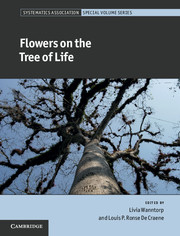Book contents
- Frontmatter
- Contents
- Contributors
- Acknowledgements
- 1 Introduction: Establishing the state of the art – the role of morphology in plant systematics
- 2 Spatial separation and developmental divergence of male and female reproductive units in gymnosperms, and their relevance to the origin of the angiosperm flower
- 3 New flowers of Laurales from the Early Cretaceous (Early to Middle Albian) of eastern North America
- 4 Tracing the early evolutionary diversification of the angiosperm flower
- 5 Changing views of flower evolution and new questions
- 6 Centrifugal stamens in a modern phylogenetic context: was Corner right?
- 7 Evolution of the palm androecium as revealed by character mapping on a supertree
- 8 Comparative floral structure and development of Nitrariaceae (Sapindales) and systematic implications
- 9 Multiplications of floral organs in flowers: a case study in Conostegia (Melastomataceae, Myrtales)
- 10 Ontogenetic and phylogenetic diversification in Marantaceae
- 11 Floral ontogeny of Acacia celastrifolia: an enigmatic mimosoid legume with pronounced polyandry and multiple carpels
- 12 Floral development of Napoleonaea (Lecythidaceae), a deceptively complex flower
- Taxon index
- Subject index
- Plate section
- References
2 - Spatial separation and developmental divergence of male and female reproductive units in gymnosperms, and their relevance to the origin of the angiosperm flower
Published online by Cambridge University Press: 07 October 2011
- Frontmatter
- Contents
- Contributors
- Acknowledgements
- 1 Introduction: Establishing the state of the art – the role of morphology in plant systematics
- 2 Spatial separation and developmental divergence of male and female reproductive units in gymnosperms, and their relevance to the origin of the angiosperm flower
- 3 New flowers of Laurales from the Early Cretaceous (Early to Middle Albian) of eastern North America
- 4 Tracing the early evolutionary diversification of the angiosperm flower
- 5 Changing views of flower evolution and new questions
- 6 Centrifugal stamens in a modern phylogenetic context: was Corner right?
- 7 Evolution of the palm androecium as revealed by character mapping on a supertree
- 8 Comparative floral structure and development of Nitrariaceae (Sapindales) and systematic implications
- 9 Multiplications of floral organs in flowers: a case study in Conostegia (Melastomataceae, Myrtales)
- 10 Ontogenetic and phylogenetic diversification in Marantaceae
- 11 Floral ontogeny of Acacia celastrifolia: an enigmatic mimosoid legume with pronounced polyandry and multiple carpels
- 12 Floral development of Napoleonaea (Lecythidaceae), a deceptively complex flower
- Taxon index
- Subject index
- Plate section
- References
Summary
Introduction: aims and terminology
It is now generally accepted that angiosperms are monophyletic and are derived from a gymnospermous ancestor. It is also widely recognized that, among extant seed-plants, angiosperm reproductive units are typically bisexual (= bisporangiate, hermaphrodite) and are termed flowers, whereas putatively comparable units produced by the four groups of gymnosperms represented in the extant flora are typically unisexual, either functionally dioecious (cycads, Ginkgo, gnetaleans) or a more complex admixture of dioecious and monoecious taxa (conifers) (e.g. Tandre et al., 1995). Individual extant gymnosperms are either monoecious, bearing male and female units on separate axes of the same plant, or dioecious, each individual bearing units of only one gender (note: in this chapter, the terms ‘male’ and ‘female’ are used consistently as colloquial shorthand for the ovuliferous and (pre)polleniferous conditions, respectively). A positive correlation with dispersal mechanism is evident, monoecious extant gymnosperms typically producing dry, wind-dispersed seeds and dioecious gymnosperms bearing fleshy, often animal-dispersed seeds (cf. Givnish, 1980; Donoghue, 1989).
Further terminological clarifications are needed. Bateman et al. (2006, p. 3472) reviewed relevant definitions before defining a flower as ‘a determinate axis bearing megasporangia that are surrounded by microsporangia and are collectively subtended by at least one sterile laminar organ’. Accepting this controversial definition means that the angiosperm flower is not unique; comparable hermaphrodite structures occur in at least one other group of seed-plants, specifically a putatively highly derived clade within bennettites (Crane, 1988). Extending this logic, the term inflorescence could also be applied more widely, to encompass axial systems that bear multiple reproductive units of gymnosperms. However, we have chosen to use throughout this chapter the more phylogenetically neutral term ‘truss’ to describe any reproductive shoot, unbranched or branched (we recognize that this usage of ‘truss’ contradicts that employed in the telome theory of Zimmermann, 1952).
- Type
- Chapter
- Information
- Flowers on the Tree of Life , pp. 8 - 48Publisher: Cambridge University PressPrint publication year: 2011
References
- 11
- Cited by

